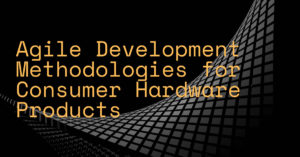
The consumer hardware industry is a highly competitive and rapidly changing field, with new technologies and advancements emerging all the time.
Keeping up with these changes can be challenging, especially when it comes to product development. One approach that has been gaining popularity in recent years is the use of agile development methodologies.
Agile development offers a number of benefits that make it well-suited for the consumer hardware industry, including the ability to adapt to change and a focus on collaboration and communication.
Benefits of Agile Product Development
Agile product development is particularly well-suited for the consumer hardware industry because it allows teams to adapt to change.
Consumer hardware projects often involve a high degree of uncertainty, with requirements and specifications changing as the project progresses. Agile allows teams to quickly respond to these changes and make adjustments as needed, which can help to keep the project on track and avoid costly delays.
Another key benefit of agile is the focus on collaboration and communication. Agile product development encourages cross-functional teams to work together closely, with regular check-ins and feedback loops to ensure that everyone is on the same page.
This can help to break down silos and improve communication between different departments and stakeholders, which is critical in the consumer hardware industry where projects can involve multiple partners and suppliers.
Agile Hardware and Software Development
The consumer hardware industry relies heavily on both hardware and software development. Agile software development methodologies, such as Scrum, provide a framework for managing the software development process and delivering software incrementally.
This allows teams to get feedback and make adjustments early on in the process, rather than waiting until the end of the project to discover that the software doesn’t meet the needs of the stakeholders.
Similarly, Agile hardware development methodologies such as Kanban or Scrum can be applied to the hardware engineering process, allowing teams to work on delivering small, incremental improvements to the product in a shorter amount of time.
This allows for faster delivery of new features and more frequent feedback, which can help to reduce the risk of costly delays or rework.
Integrating Hardware and Software Development
One of the biggest challenges in the consumer hardware industry is the need to integrate hardware and software development.
Agile development methodologies can help to bridge this gap by promoting collaboration and communication between hardware and software teams.
This can be achieved by using tools such as Kanban boards and sprint planning to ensure that both hardware and software development are aligned and progressing in parallel.
The Development Cycle
In an agile development process, the development cycle is broken down into smaller chunks, known as iterations or sprints. Each sprint is typically 2-4 weeks long and includes a planning phase, an execution phase, and a review phase.
During the planning phase, the team will identify the tasks that need to be completed during the sprint. During the execution phase, the team will work on completing those tasks.
And during the review phase, the team will review the work that was completed and identify any areas for improvement.
Valispace and Agile Development for Consumer Hardware
Valispace is a powerful tool that can help consumer hardware teams to apply agile development methodologies more effectively.
With Valispace, you can easily link your real-time requirements and system model in one central platform, streamlining your development process and enabling better collaboration between your hardware and software teams.
Book a call to assess suitability for your project or discuss bespoke needs with Valispace.
Our team will be happy to answer any questions you may have and help you determine if Valispace is the right solution for your specific needs.

